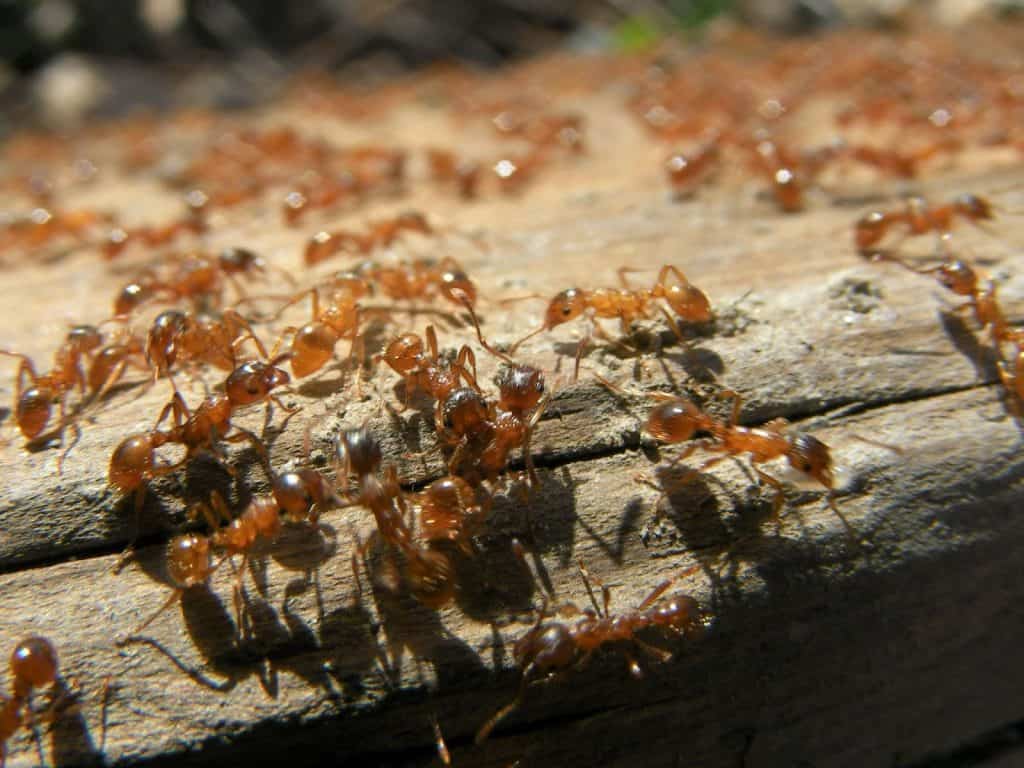The first stage of the life cycle of fire ants is the egg, just like other ant species. Then the eggs turn into larvae, then pupae, and finally the adult ant.
The average lifespan of a fire ant queen, which lives the longest, is about three years, although that can live up to six years.
In this article, I’ll discuss the lifespan and life cycle of fire ants in detail to help you understand how these ants live.
How Long Fire Ants Live
Most red ant species aren’t invasive and they don’t bother people. However, that’s not the case with the RIFA (Red Imported Fire Ant), also known as Solenopsis Invicta.
It’s the most invasive and aggressive fire ant species in the US, which has infested over 300 million acres of land since the 1930s. So, we’ll focus on this fire ant species in this article.

The lifespan of red imported fire ants is shorter than many other ant species, such as carpenter ants, and Pharaoh ants. To understand how long they live, you need to know the ant types that live in a typical fire ant colony, including the following.
Queen
Fire ant queens are reproductive females and their primary function is to lay eggs. Generally, an ant queen seeks to build its own mound/nest after the nuptial flight, to lay eggs and start a new colony.
As mentioned above, the average lifespan of queen ants is about three years, and they live somewhere between two to six years. The queens are the largest fire ants and they also live the longest.
Males
The purpose of the male ants is to mate with young females. They inseminate the females in the nuptial flight and die soon after that. The females that have been inseminated turn into queens.
Worker Ants
On average, fire ant workers usually live somewhere between four and six weeks, once they have emerged as adults. However, this type of ant can survive for longer, depending on the size of the worker ant and the temperature of the environment.
Large workers can live up to six months, medium up to three months, and small up to two months. Plus, the duties of worker ants can also change as they age. For example, the oldest worker ants forage outside fire ant mounds, and the youngest ones take care of the queen ant and brood.
It also means that the fire ants that you usually see outside, searching for food, are already old, and might live only a few weeks or even days.
Fire Ant Life Cycle
The winged males and female ants mate during the nuptial flight at a height of 250 meters or more. Once the males have inseminated the females, they refuse to go to the mother ant colony and die outside the mound.
Females land on the ground and quickly find suitable nesting sites. After finding the right location, the newly-mated queens start laying eggs. The queen lays about 10 to 15 eggs within 24 hours of mating.
These eggs hatch within 10 days and turn into larvae. By this time the queen usually has laid up to 125 more eggs and they go through the same hatching process.
The larval stage of fire ants lasts about six to 12 days and then they turn into pupae. The pupal stage lasts for nine to 16 days. At this point, the queen stops laying eggs and helps the newly born immature workers to develop.
The queen ant takes care of only the first brood of larvae to help them develop into worker ants. Once the colony has worker ants, they start to bring food to the nest, look after the queen and new brood, and defend and maintain the nest.
Fire Ant Colonies
The imported red fire ant colonies can have multiple queens, and a single queen, if well-fed, can lay up to 1,500 eggs in one day. It increases the population of the entire colony rapidly.

In order to accommodate this fast-paced growth, the worker ants build a big network of chambers and tunnels underground. It includes both living spaces and nurseries for adult ants.
When a nest reaches its maximum capacity, the worker ants help the queen to move out of the colony and find a new place to establish a new nest.
The size of a mound grows as the population expands. On average, the size of a single mound can range from 18 to 30 inches. The tunnels and chambers help fire ants survive severe weather by regulating underground temperature.
Factors That Affect the Lifespan of Fire Ants
The following are the common factors that affect the lifespan of red imported fire ants.
Gender
The lifespan of male fire ants is only a few days. That’s because their sole purpose is to inseminate the young females. The males die soon after the nuptial flight, once they and young females have mated. Whereas, female fire ants, which turn into queens, last the longest.
While worker fire ants are also female, they don’t mate and can’t lay eggs. Most ants you see are workers and their job is to bring food to the nest, feed and take care of the queen and new brood, and build and defend the colony.
Outside Forces
There’s always a chance that the life of an ant is cut short by a professional exterminator, invader, or predator. Many fire ants also die during a war with termites or other ant species. Worker ants are the ones that got affected due to outside forces in most cases.
Available Resources
The ability of workers to find and bring food for the entire population of the colony is critical for survival. During extremely dry and hot weather conditions, the colony can suffer due to the shortage of food and it can decrease the lifespan of ants.
Final Words
While the lifespan of fire ants is shorter than many other ant species, they are more aggressive and invasive. The average lifespan of fire ant queens is about three years, but they can live up to six years.
Whereas male fire ants live only for a few days and die soon after inseminating the females. Lastly, the worker ants usually live between four and six weeks but they can have a longer lifespan, depending on their size and outside temperature.
Recommended Reading:
